Mexican cuisine is known for its vibrant flavors, symbolic dishes, and unique presentation styles. Among these culinary delights is the intriguingly named divorced enchiladas, or enchiladas divorciadas. This dish offers a split personality of sorts, featuring two distinct sauces—red and green—symbolizing a “separation” of flavors. But where did the term “divorced” come from, and why does it resonate with so many food lovers? In this article, we’ll uncover the origins of the name, delve into the history and cultural significance of the dish, and explore what makes it a favorite in Mexican households and beyond.
Understanding Enchiladas Divorciadas
What Are Divorced Enchiladas?
Divorced enchiladas are a playful yet delicious spin on traditional enchiladas. Unlike their fully unified counterparts, which are smothered in a single sauce, these enchiladas are presented with two distinct sauces—one red and one green—divided right down the middle of the plate. This “divorce” of sauces creates a visual and flavorful contrast that sets the dish apart.
Typically, the enchiladas are stuffed with a filling of your choice, such as shredded chicken, cheese, or beans, and then layered with the two contrasting sauces. The bold, tangy red sauce often comes from tomatoes and chilies, while the vibrant green sauce is crafted from tomatillos and fresh herbs. Each bite delivers a distinct burst of flavor, offering a culinary adventure for the taste buds.
Origin of the Name
The name “divorciadas” translates to “divorced” in English, and it’s a metaphorical nod to the divided nature of the dish. The red and green sauces, though delicious on their own, symbolize separation—each claiming its space on the plate. This playful interpretation reflects Mexican culture’s knack for infusing humor and storytelling into food.
The name also represents the culinary contrast between the two sauces, which, despite their differences, coexist harmoniously in one dish. It’s a lighthearted representation of opposites working together to create something greater, much like Mexico’s diverse culinary heritage.
The History Behind Divorced Enchiladas
Traditional Mexican Cuisine and Its Symbolism
The roots of Mexican cuisine run deep, weaving together history, culture, and creativity. Divorced enchiladas, or enchiladas divorciadas, are a perfect example of this fusion. Traditionally, enchiladas were a humble dish—corn tortillas filled with simple ingredients like beans or cheese, topped with a sauce that brought everything together. Over time, variations like divorced enchiladas emerged, offering a creative twist on the classic.
The symbolism behind divorced enchiladas goes beyond the plate. The red and green sauces represent a playful yet meaningful contrast, symbolizing balance and duality. This mirrors the broader themes in Mexican culture, where food often tells stories of identity and diversity. The dish’s name also reflects the ability to find harmony in differences—something deeply rooted in Mexican traditions.

Evolution of the Recipe
The evolution of enchiladas divorciadas reflects the dynamic nature of Mexican cuisine. While traditional enchiladas date back centuries to the Aztecs, the concept of “divorced” sauces likely emerged in modern times, inspired by Mexico’s rich culinary experimentation. Over the years, chefs have embraced this idea, creating regional variations to suit local tastes.
From bold, smoky chili-based red sauces to tangy, tomatillo-forward green sauces, the flavor profiles of divorced enchiladas have become as diverse as the people who enjoy them. Today, the dish is celebrated in homes and restaurants alike, symbolizing the beauty of culinary innovation while staying true to its roots.
Key Ingredients and Preparation
The Two Sauces
The hallmark of divorced enchiladas is their distinct sauces. The red sauce is often made from ingredients like tomatoes, dried chilies, garlic, and spices. Its smoky, slightly spicy flavor contrasts beautifully with the green sauce, which features fresh tomatillos, cilantro, and green chilies. Both sauces add bold, complementary flavors that make every bite exciting.
The use of these two sauces also highlights the versatility of Mexican cuisine. Home cooks can adapt recipes based on availability, opting for canned or fresh ingredients, depending on what’s on hand. This adaptability is a testament to the ingenuity that has kept this dish popular through generations.
Core Components of the Dish
While the sauces take center stage, the other components are equally important. Fresh corn tortillas form the base of the dish, providing a soft yet sturdy foundation for the fillings. Popular options include shredded chicken, cheese, or refried beans, though vegetarian and vegan fillings have grown increasingly popular in recent years.
Once assembled, the enchiladas are arranged side by side, with each half of the plate adorned in its respective sauce. Garnishes like crumbled cheese, sliced avocado, and fresh cilantro add a finishing touch, making the dish as visually striking as it is delicious. For a full meal, serve with sides like Mexican rice or a fresh salad.
Why the Name Resonates: Cultural and Emotional Connection
Representation of Mexican Culinary Identity
Why are they called divorced enchiladas? The name is more than a playful label—it’s a reflection of Mexico’s culinary creativity and cultural storytelling. Food in Mexico often symbolizes more than nourishment; it’s a means of expressing values, relationships, and traditions. Divorced enchiladas, with their bold division of red and green sauces, tell a story of contrast and coexistence.
This dish highlights the duality of flavors that is so central to Mexican cuisine. The combination of smoky, spicy red sauce and tangy, fresh green sauce creates a beautiful harmony of opposites, much like the country’s cultural and geographic diversity. Divorced enchiladas are not just a meal; they are a reminder of the unity in diversity, a theme deeply embedded in Mexican life.
A Symbol of Choice and Balance
Another reason the name resonates is the sense of balance it represents. In life, as in food, opposites often come together to create something greater than the sum of their parts. Divorced enchiladas symbolize this concept by offering two distinctly different flavors, side by side, without one overpowering the other.
Emotionally, this dish connects with diners who see themselves in its duality. Whether you prefer one sauce over the other or love the interplay between them, divorced enchiladas let you embrace your preferences without compromise. It’s a dish that celebrates choice and individuality, which makes it all the more relatable.
FAQs About Divorced Enchiladas
What Makes Divorced Enchiladas Different From Other Enchiladas?
Divorced enchiladas are unique because they feature two distinct sauces instead of one. Traditional enchiladas are usually smothered in a single sauce, while enchiladas divorciadas split the plate with red and green sauces, offering a variety of flavors in every bite. This division is what earns them their “divorced” moniker.
Are Divorced Enchiladas Always Made the Same Way?
Not at all! While the concept of two sauces is consistent, the specific recipes vary widely. Some cooks prefer spicy red sauces, while others opt for sweeter versions. Similarly, green sauces can range from tangy to creamy. The choice of fillings—chicken, cheese, or beans—also depends on regional preferences and personal taste.
What’s the Best Way to Serve Divorced Enchiladas?
Presentation is key when serving divorced enchiladas. Arrange the enchiladas on the plate, dividing the red and green sauces neatly. Garnish with crumbled cheese, sliced avocado, and fresh cilantro for a visually stunning dish. Pairing the enchiladas with a side of Mexican rice or a crisp salad can elevate the meal further.

Can You Use Other Sauces for Divorced Enchiladas?
Absolutely! While red and green sauces are traditional, some cooks experiment with mole or creamy white sauces for a twist. The beauty of enchiladas divorciadas lies in their adaptability, allowing you to tailor the flavors to your liking.
Final Thoughts and Takeaways
Wrapping Up the Story Behind Divorced Enchiladas
So, why are they called divorced enchiladas? This charming name captures the essence of the dish—a playful division of flavors that come together harmoniously on the plate. The use of two distinct sauces, red and green, symbolizes separation while also celebrating balance and choice. It’s a dish that transcends its ingredients, embodying the creativity and cultural depth of Mexican cuisine.
Why This Dish Matters
Divorced enchiladas remind us that food is about more than taste—it’s about storytelling, tradition, and identity. By understanding the history and significance of this dish, we connect not only with its flavors but also with the culture that created it. Whether you stick to classic red and green sauces or put your spin on the recipe, this dish invites you to celebrate diversity and individuality.
Creative Variations of Divorced Enchiladas
Exploring New Flavors for Divorced Enchiladas
One of the joys of enchiladas divorciadas is how adaptable they are. While the traditional red and green sauces remain iconic, many cooks experiment with creative twists to make the dish their own. For instance, you could swap the red sauce for a smoky chipotle version or the green sauce for a creamy avocado blend. Adding unique spices like cumin or cinnamon can also give the dish a new dimension.
Another way to customize divorced enchiladas is by changing the fillings. Instead of classic chicken or cheese, consider shredded pork, sautéed vegetables, or even seafood. These variations keep the dish fresh and exciting while still honoring its roots. The beauty of this dish lies in its versatility—allowing it to evolve without losing its essence.
Pairing Divorced Enchiladas with Sides and Drinks
To elevate the meal, serve divorced enchiladas with complementary sides like Mexican rice, refried beans, or a fresh salad. Drinks also play a crucial role in enhancing the dining experience. A classic margarita or a refreshing agua fresca pairs beautifully with the bold flavors of the enchiladas.
Bringing Divorced Enchiladas to Your Table
Why Divorced Enchiladas Are Worth Making
Why are they called divorced enchiladas? The answer lies in the dish’s delightful duality. Not only do the red and green sauces symbolize contrast, but they also invite creativity and balance into the kitchen. Whether you’re an experienced cook or a beginner, this dish is a fantastic way to explore the vibrant flavors of Mexican cuisine.
Tips for Success in the Kitchen
To ensure your enchiladas divorciadas turn out perfectly, start with fresh ingredients. Homemade sauces bring depth and richness to the dish, but store-bought options can work in a pinch. Arrange the enchiladas neatly on the plate to highlight the visual impact of the divided sauces, and don’t forget to garnish with fresh cilantro or crumbled cheese for added flair.

